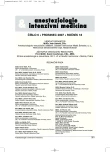Neuromodulation in chronic pain management
Authors:
M. Hakl 1; P. Ševčík 2
Authors‘ workplace:
Centrum pro léčbu bolesti Anesteziologicko-resuscitační kliniky FN u sv. Anny v Brně a LF MU Brno
1; Klinika anesteziologie, resuscitace a intenzivní medicíny FN Brno a LF MU Brno
2
Published in:
Anest. intenziv. Med., 18, 2007, č. 6, s. 340-344
Category:
Algeziology
Overview
Neuromodulation methods include management strategies employing the application of agents or a defined electric current directly to the nerve structures. Modern neurostimulation management is based on the concept of the gate theory of pain formulated by Melzack and Wall in 1965. The principle of spinal cord stimulation is based on an increased release of inhibitor substances (endorphins, enkephalins, dynorpfines). Segmental spinal mechanisms play an important role in the therapeutic effect. Spinal cord stimulation is suitable in the treatment of chronic neuropathic and ischaemic pain. In appropriately selected patients very good results are achievable up to a decrease of the VAS pain score from 8–10 to 0–2. Implanted intrathecal drug delivery systems are indicated in some severe types of chronic pain especially of the nociceptive character, or in severe forms of central spastic syndromes.The implantable pumps can be crudely divided into programmable and non-programmable.The fundamental analgesic for long-term intrathecal application is morphine and for intrathecal spasticity treatment it is baclofen. Neuromodulation methods are reserved for a relatively narrow group of patients suffering from chronic pain syndromes unresponsive to other strategies. When used correctly their efficacy greatly exceeds the efficacy of the classic farmacological approach.
Key words:
spinal cord stimulation – cortical stimulation – implantable intrathecal drug application systems – neuropathic pain – morphine – baclofen
Labels
Anaesthesiology, Resuscitation and Inten Intensive Care MedicineArticle was published in
Anaesthesiology and Intensive Care Medicine

2007 Issue 6
Most read in this issue
- Neuromodulation in chronic pain management
- Cardiocerebral resuscitation: For laymen without ventilation?
- Advances in general anaesthesia
- Lipid resuscitation: Progress in the pharmacology of local anaesthetics – a view from the perspective of the year 2007
